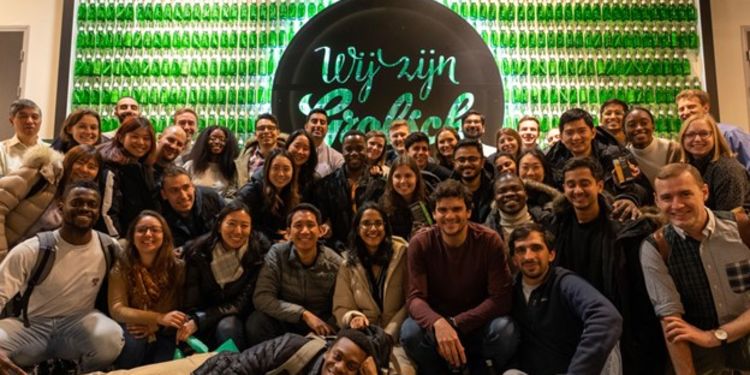In January 2023, Professors Willy Shih and Mike Toffel led more than 40 HBS MBA students on site visits to witness the energy transition and innovative sustainable production activities throughout Denmark and the Netherlands, in their new Immersive Field Course (IFC). This is one of 13 student essays posted on the HBS Business and Environment Initiative’s Blog that highlights their reflections. Learn more about this IFC course on Decarbonization and Sustainable Production by watching this five minute video summary.
Visit Date: January 11, 2023
At Grolsch Brewery in the eastern Netherlands city of Enschede, our group of students heard about the beer company’s corporate sustainability initiatives, saw these initiatives in action during our brewery tour, and then got to taste their results in an on-site beer sampling. Their innovations ranged from sustainable packaging to resource efficiency to heat and energy sourcing. Many of these initiatives were reminiscent of practices at other sites we had visited over the past two weeks, even in different industries, which helped us tie together many of the threads and outstanding questions that arose throughout our trip.

Highlights: Product and Operational Sustainability Initiatives
Sustainable Packaging. One of the most surprising facts we learned at Grolsch is that the average beer bottle in the Netherlands is recycled 25 times. Dutch consumers are used to recycling their beer bottles at their local supermarket, which sends bottles back to brewers to be cleaned and refilled with new products. In this way, their standard bottling practices already reflect their ambitions to maximize circularity. Beyond this baseline, Grolsch shared that they’ve recently innovated a recyclable cardboard “TopClip” to replace the conventional glue and plastic approach to hold a six-pack together. We learned that this innovation has resulted in significant savings in methane emissions. Grolsch is also investigating potential alternatives to plastics for its other shipping packaging.
Resource Efficiency. In 2004, Grolsch had a beer-to-water ratio of 1:5.5, indicating a high water intensity of beer production. By 2022 they had gotten that ratio down to 1:3.8 and are continuing to improve their water efficiency through initiatives such as reusing wastewater for cleaning production facilities. They’re also starting work with distributors and retailers such as pubs and restaurants that serve Grolsch beers and perform “sustainability scans” to increase drafting efficiency and reduce “beer loss.”
Heat and Energy. Grolsch has transitioned from three natural gas-powered boilers powering their brewery in 2008 to one back-up boiler today by switching to sourcing “green heat” from nearby sustainable energy producer, Twence, which uses renewable energy sources to deliver piped hot water to the brewery. Grolsch is also working on converting its own biogas from brewery operations into biogas (renewable natural gas).
Key Takeaways: Crisis Times, Regulation and Collaboration
One of our biggest takeaways from this visit was the extent to which the current European energy crisis altered the payback periods for their in-flight (ongoing) and potential upcoming sustainability investments. At Grolsch and many other sites, we consistently heard that times of crisis can also be times of transition and opportunity because spikes in energy prices can improve the business cases for investment in renewable projects.
Another takeaway was the extent to which Grolsch and many other companies we visited were supportive of market interventions by government policy and regulation to encourage sustainable investments. For example, Grolsch shared that taxes on landfilling (which is now prohibited in the Netherlands) and water pollution helped shorten the payback periods of various sustainability projects that they were consequently able to invest in.
Finally, another major takeaway was the extent to which industry collaboration can drive sustainability improvements across the board. When we asked Grolsch whether they shared their sustainability innovations with other brewers in the region, they confirmed that collaboration on sustainable technology was a norm in the industry and region, and that they saw sustainable technology sharing as a crucial component of driving necessary change.
Our Remaining Questions
Supply Chain Emissions. Although Grolsch shared some sustainability initiatives in their supply chain, including a pilot program equipping commercial trucks with solar panels that power the trucks loading and unloading chain, we remain curious about other supply chain initiatives. Specifically, we wonder about the environmental impacts of the raw material inputs like barley and hops, and any programs they might be considering to source these feedstocks more sustainably or increase their use efficiency.
Consumer Behavioral Change. Throughout the tour of sites around Denmark and the Netherlands, our group asked many of our hosts how they thought their learnings might apply to other markets like the United States. This question was particularly relevant at Grolsch, where bottle recycling was a big component of their circularity and dependent on the common Dutch practice of consumers consistently returning used bottles to supermarkets. We visited several other sites where encouraging consumer product-return was a major challenge because of the behavioral change required for that industry, hence we continued to wrestle with the question of how consumer bottle return for refilling could be normalized in other markets.
Regulatory Pathways. Because Grolsch was so forthcoming about how policy and regulation helped make viable business cases for their sustainable investments, our group thought about potential pathways to similar regulations in other markets. While we heard from lobbyists at several other sites we visited, many of us continued to discuss what types of lobbying and policies might be best suited to sustainability transformations in other industries and geographies.
-----
Read more posts in the IFC Series:
Deconstructing LEGO’s Decarbonization
Port Esbjerg: Deploying Offshore Wind
HySynergy and Crossbridge Energy
Grundfos: Innovation & Inspiration for Sustainable Product Design
Arla Foods: How Sustainable Can A Dairy Company Be?
Amager Bakke: A Look into the Future of Waste Incineration
Maersk’s Journey to Decarbonize Shipping
BTG Bioliquids: Creating Fast Pyrolysis Bio-Oil from Biomass Residue Streams
Grolsch Brewing Company: Drink Sustainably
Van den Ende Rozen: Greenhouse Rose Production

